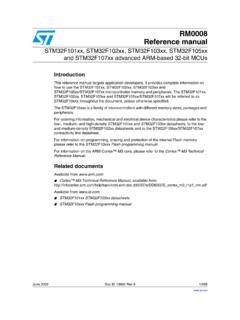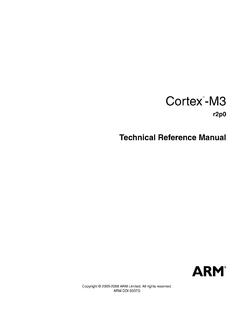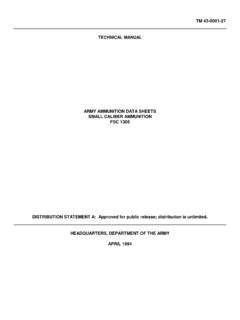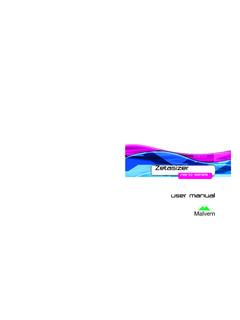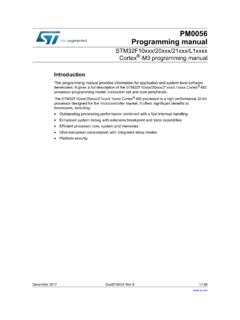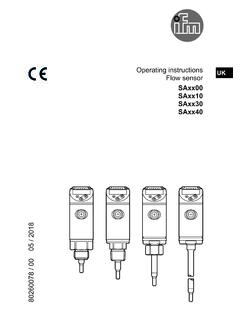Transcription of PM0075 Programming manual - STMicroelectronics
1 August 2012 Doc ID 17863 Rev 21/31PM0075 Programming manualSTM32F10xxx Flash memory microcontrollersIntroductionThis Programming manual describes how to program the Flash memory of STM32F101xx, STM32F102xx, STM32F103xx, STM32F105xx and STM32F107xx microcontrollers. For convenience, these will be referred to as STM32F10xxx in the rest of this document unless otherwise STM32F10xxx embedded Flash memory can be programmed using in-circuit Programming or in-application in-circuit Programming (ICP) method is used to update the entire contents of the Flash memory, using the JTAG, SWD protocol or the boot loader to load the user application into the microcontroller.
2 ICP offers quick and efficient design iterations and eliminates unnecessary package handling or socketing of devices. In contrast to the ICP method, in-application Programming (IAP) can use any communication interface supported by the microcontroller (I/Os, USB, CAN, UART, I2C, SPI, etc.) to download Programming data into memory. IAP allows the user to re-program the Flash memory while the application is running. Nevertheless, part of the application has to have been previously programmed in the Flash memory using Flash interface implements instruction access and data access based on the AHB protocol. It implements a prefetch buffer that speeds up CPU code execution.
3 It also implements the logic necessary to carry out Flash memory operations (Program/Erase). Program/Erase operations can be performed over the whole product voltage range. Read/Write protections and option bytes are also b l e 1 lists the microcontrollers and evaluation tool concerned by this Programming manual . Table products TypeApplicable productsMicrocontrollersSTM32F101xx, STM32F102xx, STM32F103xx, STM32F105xx and STM32F107xx microcontrollersEvaluation toolSTM3210C-EVAL evaluation ContentsPM00752/31 Doc ID 17863 Rev 2 Contents1 Overview .. module organization .. 62 Reading/ Programming the embedded Flash memory.
4 Operation .. fetch .. interface .. access controller .. program and erase controller (FPEC) .. values .. the Flash memory .. Flash memory Programming .. memory erase .. byte Programming .. protection .. protection .. byte block write protection .. byte description .. 193 Register descriptions .. access control register (FLASH_ACR) .. key register (FLASH_KEYR) .. OPTKEY register (FLASH_OPTKEYR) .. status register (FLASH_SR) .. control register (FLASH_CR) .. address register (FLASH_AR) .. byte register (FLASH_OBR) .. protection register (FLASH_WRPR).
5 Register map .. 294 Revision history .. 30PM0075 List of tablesDoc ID 17863 Rev 23/31 List of tablesTable products .. 1 Table module organization (low-density devices) .. 7 Table module organization (medium-density devices) .. 7 Table module organization (high-density devices) .. 8 Table module organization (connectivity line devices) .. 9 Table memory protection status .. 18 Table byte format .. 19 Table byte organization .. 20 Table of the option bytes .. 20 Table .. 23 Table interface - register map and reset values .. 29 Table revision history .. 30 List of figuresPM00754/31 Doc ID 17863 Rev 2 List of figuresFigure procedure.
6 13 Figure memory Page Erase procedure .. 15 Figure memory Mass Erase procedure .. 16PM0075 Doc ID 17863 Rev 25/31 GlossaryThis section gives a brief definition of acronyms and abbreviations used in this document: Low-density devices are STM32F101xx, STM32F102xx and STM32F103xx microcontrollers where the Flash memory density ranges between 16 and 32 Kbytes. Medium-density devices are STM32F101xx, STM32F102xx and STM32F103xx microcontrollers where the Flash memory density ranges between 64 and 128 Kbytes. High-density devices are STM32F101xx and STM32F103xx microcontrollers where the Flash memory density ranges between 256 and 512 Kbytes.
7 Connectivity line devices are STM32F105xx and STM32F107xx microcontrollers. The Cortex-M3 core integrates two debug ports: JTAG debug port (JTAG-DP) provides a 5-pin standard interface based on the Joint Test Action Group (JTAG) protocol. SWD debug port (SWD-DP) provides a 2-pin (clock and data) interface based on the Serial Wire Debug (SWD) both the JTAG and SWD protocols please refer to the Cortex M3 Technical reference manual Word: data/instruction of 32-bit length Half word: data/instruction of 16-bit length Byte: data of 8-bit length FPEC (Flash memory program/erase controller): write operations to the main memory and the information block are managed by an embedded Flash program/erase controller (FPEC).
8 IAP (in-application Programming ): IAP is the ability to re-program the Flash memory of a microcontroller while the user program is running. ICP (in-circuit Programming ): ICP is the ability to program the Flash memory of a microcontroller using the JTAG protocol, the SWD protocol or the boot loader while the device is mounted on the user application board. I-Code: this bus connects the Instruction bus of the Cortex-M3 core to the Flash instruction interface. Prefetch is performed on this bus. D-Code: this bus connects the D-Code bus (literal load and debug access) of the Cortex-M3 to the Flash Data Interface. Option bytes: product configuration bits stored in the Flash memory OBL: option byte loader.
9 AHB: advanced high-performance bus. OverviewPM00756/31 Doc ID 17863 Rev 21 Features up to 512 Kbytes of Flash memory Memory organization: Main memory block:4 Kbits 64 bits for low-density devices16 Kbits 64 bits for medium-density devices64 Kbits 64 bits for high-density devices32 Kbits 64 bits for connectivity line devices Information block:2306 64 bits for connectivity line devices258 64 bits for other devicesFlash memory interface (FLITF) features: Read interface with prefetch buffer (2 64-bit words) Option byte Loader Flash Program / Erase operation Read / Write protection Low-power Flash module organizationThe memory organization is based on a main memory block containing 32 pages of 1 Kbyte (for low-density devices), 128 pages of 1 Kbyte (for medium-density devices), 128 pages of 2 Kbyte (for connectivity line devices) or 256 pages of 2 Kbyte (for high-density devices), and an information block as shown in Ta b l e 3 and Ta b l e ID 17863 Rev 27/31 Table module organization (low-density devices)BlockNameBase addressesSize (bytes)
10 Main memoryPage 00x0800 0000 - 0x0800 03FF1 KbytePage 10x0800 0400 - 0x0800 07FF1 KbytePage 20x0800 0800 - 0x0800 0 BFF1 KbytePage 30x0800 0C00 - 0x0800 0 FFF1 KbytePage 40x0800 1000 - 0x0800 13FF1 310x0800 7C00 - 0x0800 7 FFF1 KbyteInformation blockSystem memory0x1 FFF F000 - 0x1 FFF F7FF2 KbytesOption Bytes0x1 FFF F800 - 0x1 FFF F80F16 Flash memory interface registersFLASH_ACR0x4002 2000 - 0x4002 20034 FLASH_KEYR0x4002 2004 - 0x4002 20074 FLASH_OPTKEYR0x4002 2008 - 0x4002 200B4 FLASH_SR0x4002 200C - 0x4002 200F4 FLASH_CR0x4002 2010 - 0x4002 20134 FLASH_AR0x4002 2014 - 0x4002 20174 Reserved0x4002 2018 - 0x4002 201B4 FLASH_OBR0x4002 201C - 0x4002 201F4 FLASH_WRPR0x4002 2020 - 0x4002 20234 Table module organization (medium-density devices)BlockNameBase addressesSize (bytes)










